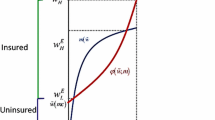Abstract
One theory of insurance markets suggests that entering insurers expect incumbent insurers to react to the entry of new products, offering a combination of products where, breaking even, one makes positive economic profits and the other makes a loss. This theory is extended to include moral hazard, in which the magnitude of the loss depends on insurance coverage, and a stylized model of managed care. With moral hazard, cross-subsidization is still predicted. In contrast to prior results, the coverage for the highest risk individuals will vary with the portion of high-risk individuals in the market. The inclusion of managed care as a signaling instrument does not disrupt cross-product subsidization. These theoretical predictions are discussed in light of the absence of empirical support to date and in light of other factors that might limit or enhance an insurer's ability to subsidize across products.
Similar content being viewed by others
References
Arrow, Kenneth.Essays in the Theory of Risk Bearing, Chicago, IL: Markham Publishing, 1971.
Baumgardner, James R. “The Interaction Between Forms of Insurance Contracts and Types of Technical Change in Medical Care,”Rand Journal of Economics, 22, 1, 1991, pp. 36–53.
Berki, S. E.; Ashcraft, Marie L. F. “HMO Enrollment: Who Joins What and Why: A Review of the Literature,”Milbank Memorial Fund Quarterly, 58, 4, 1980, pp. 588–634.
Billi, John E.; Wise, Christopher G.; Sher, Scott I.; Duran-Arenas, Luis; Shapiro, Letitia. “Selection in a Preferred Provider Organization Enrollment,”Health Services Research, 28, 5, 1993, pp. 563–75.
Cave, Jonathon A. K. “Subsidy Equilibrium and Multiple-Option Insurance Markets,”Advances in Health Economics and Health Services Research, 6, 1985, pp. 27–45.
__.Equilibrium in Insurance Markets with Asymmetric Information and Adverse Selection, Report R-3015-HHS, Santa Monica, CA: The RAND Corporation, 1984.
Frick, Kevin D.Essays on Health Insurance Markets: Asymmetric Information and Multiple Periods, unpublished dissertation, Ann Arbor, MI: University of Michigan, 1996.
Gabel, Jon. “Ten Ways HMOs Have Changed During the 1990s,”Health Affairs, 16, 3, 1997, pp. 134–45.
Gold, Marsha; Hurley, Robert; Lake, Timothy; Ensor, Todd; Berenson, Robert.Arrangements Between Managed Care Plans and Physicians: Results from a 1994 Survey of Managed Care Plans, Washington, DC: Physician Payment Review Commission, 1995.
Gordon, Nancy P.; Kaplan, George A. “Some Evidence Refuting the HMO ‘Favorable Selection” Hypothesis: The Case of Kaiser Permanente,”Advances in Health Economics and Health Services Research, 12, 1991, pp. 19–39.
HCIA.HMO Database, Premiums per Member Month, diskette version, Baltimore, MD: HCIA, 1993.
InterStudy.InterStudy Edge 1992–1994, Bloomington, MN: InterStudy, 1994.
Levy, Haim. “Absolute and Relative Risk Aversion: An Experimental Study,”Journal of Risk and Uncertainty, 8, 3, 1994, pp. 289–307.
Miyazaki, Hajime. “The Rat Race and Internal Labor Markets,”The Bell Journal of Economics, 8, 3, 1977, pp. 394–418.
Newhouse, Joseph P. “Reimbursing Health Plans and Health Providers: Efficiency in Production versus Selection,”Journal of Economic Literature, 34, 3, 1996, pp. 1236–53.
Robinson, James C.; Gardner, Laura B.; Luft, Harold S. “Health Plan Switching in Anticipation of Increased Medical Care Utilization,”Medical Care, 31, 1, 1993, pp. 43–51.
Rothschild, Michael; Stiglitz, Joseph E. “Equilibrium in Competitive Insurance Markets: An Essay on the Economics of Imperfect Information,”Quarterly Journal of Economics, 90, 4, 1976, pp. 630–49.
Spence, Michael. “Product Differentiation and Performance in Insurance Markets,”Journal of Public Economics, 10, 3, 1978, pp. 427–47.
Strumwasser, Ira; Paranjpe Nitin V.; Ronis, David L.; McGinnis, Jiene; Kee, David W.; Hall, Hallet L. “The Triple Option Choice: Self-Selection Bias in Traditional Coverage, HMOs, and PPOs,”Inquiry, 26, 4, 1989, pp. 432–41.
Weiner, Jonathon P; de Lissovoy, Gregory. “Razing a Tower of Babel: A Taxonomy for Managed Care and Health Insurance Plans,”Journal of Health Politics, Policy and Law, 18, 1, 1993, pp. 75–103.
White House Domestic Policy Council.Health Security: The President's Report to the American People, New York, NY: Simon and Schuster, 1993.
Wholey, Douglas R.; Christianson, Jon B. “Product Differentiation Among Health Maintenance Organizations: Causes and Consequences of Offering Open-Ended Products,”Inquiry, 31, 1, 1994, pp. 25–39.
Wholey, Douglas; Feldman, Roger; Christianson, Jon B. “The Effect of Market Structure on HMO Premiums,”Journal of Health Economics, 14, 1, 1995, pp. 81–106.
Wilson, Charles. “A Model of Insurance Markets with Incomplete Information,”Journal of Economic Theory, 16, 2, 1977, pp. 167–207.
Author information
Authors and Affiliations
Rights and permissions
About this article
Cite this article
Frick, K.D. Cross product subsidization in the health insurance market with managed care: A model and issues. Atlantic Economic Journal 27, 121–134 (1999). https://doi.org/10.1007/BF02300233
Issue Date:
DOI: https://doi.org/10.1007/BF02300233




